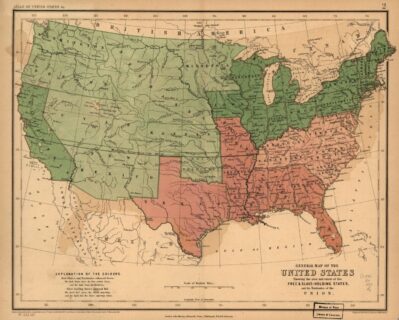
Rogers, Henry D. General map of the United States, showing the area and extent of the free & slave-holding states, and the territories of the Union. [London: John Murray ; Edinburgh: W. & A.K. Johnston, 1857] Library of Congress, G3701.E9 1857 .R6 MLC.
Toolkit
Expansion and Sectionalism Toolkit
From the first years of the republic under the Constitution through the 1850s, America experienced rapid growth and expansion, opening new lands and opportunities for its people, and experiencing a variety of growing pains in the process. Political, social, and economic challenges confronted American political leaders, in some cases threatening the union.
This topic focuses primarily on Westward Expansion as related to the issue of Sectionalism, and for the sake of this focus does not include consideration of other important topics of the era, including agricultural and industrial breakthroughs, and reform movements.
Guiding Questions
- What did Americans think were the advantages and the perils of expansionism?
- How did reform movements, many of which had their origin during the Jackson presidency (1829-1837), affect American attitudes on slavery and expansion?
- How did Americans differ on the Constitution as well as state and federal power within the debate on expansion and slavery?
- How did slavery and expansion together poison American politics?
Essential Documents
- First Inaugural Address, 1801, Thomas Jefferson
- Letter to John Holmes, 1820, Thomas Jefferson
- Monroe Doctrine, 1823, James Monroe
- The Webster-Hayne Debates, 1830
- Fort Hill Address, 1831, John C. Calhoun
- Proclamation Regarding Nullification, 1832, Andrew Jackson
- On the Constitution and the Union, 1832, William Lloyd Garrison
- What a Revival of Religion Is, 1835, Charles Finney
- “What to the Slave is the Fourth of July?,” 1852, Frederick Douglass
- Speech on the Repeal of the Missouri Compromise, 1854, Abraham Lincoln
Resources
Webinars
- American Minds: Henry Clay
- Documents in Detail: “What to the Slave is the Fourth of July?”
- Documents in Detail: Monroe Doctrine
- Great American Debates: Lincoln vs. Douglas
- Moments of Crisis: Nullification Crisis
- Moments of Crisis: Election of 1800
- Landmark Supreme Court Cases: Marbury v. Madison
- Landmark Supreme Court Cases: McCulloch v. Maryla\nd
- Landmark Supreme Court Cases: Dred Scott v. Sandford
- American Presidents: James Madison
- American Presidents: Andrew Jackson
- American Presidents: James K. Polk
- American Controversies: Is there a Constitutional Right to Nullification or Secession?
- Special Webinar: What Can We Learn from the Election of 1800?
Lesson Plans
- Jigsawing Lincoln and Stephens – a weeklong series of lessons focused on the words and ideas of the Lincoln-Douglas Debates
- A House Dividing – four related lessons about the growing sectional rift between North and South
- Sectionalism and the Mexican-American War – A study of the connection between the Mexican-American War and growing political and sectional divides in mid-19th Century America
- Slavery Through the Eyes of a Slave – A study of the life and views of a slave from Frederick Douglass
- Jackson Vetoes the National Bank – study the competing politics and constitutional interpretations related to the debate over the National Bank during Jackson’s time as president
- Secession: Constitutional or Legal? – Building on Southern ideas related to nullification and attitudes about federal power, this lesson explores Southern rationale for secession in 1860
